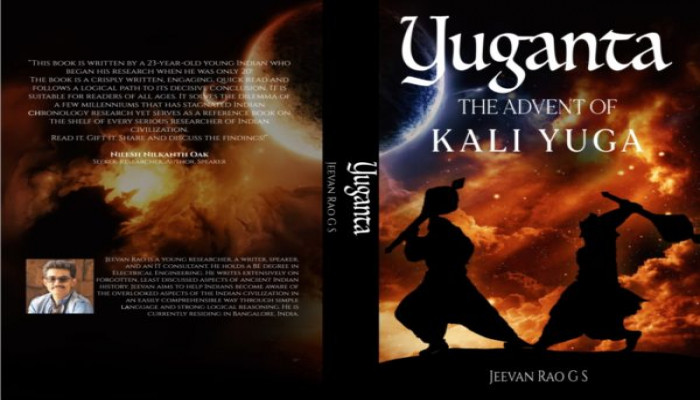Yuganta: The Advent of Kali Yuga
- In Book Reviews
- 09:11 AM, Nov 08, 2022
- Ramaharitha Pusarla
In response to a petition in 2007, defending the Setusamudram project, the UPA government told the Supreme Court, “the contents of the Valmiki Ramayana, the Ramcharitamanas by Tulsidas and other mythological texts, which admittedly form an important part of ancient Indian literature… cannot be said to be a historical record to incontrovertibly prove the existence of the characters, or the occurrence of the events, depicted therein”. A vast section of the so-called opinion-makers and a cabal of historians perpetrated a narrative stating, “History requires concrete evidence in the form of coins, inscriptions, etc to prove the existence of a character. Even if we take into account the places mentioned in the Ramayana like Chitrakoot, and Ayodhya which still exist, the fact is that Ramayana is not a historical text. So, from that perspective, there is no historical evidence of Ram. Having said that, we still cannot negate Ram’s presence easily, since he has been part of our collective consciousness for a long time”2.
The dubious narrative notwithstanding the traditional categorization of the Ramayana and Mahabharata as ‘Itihasas’ meaning “thus verily happened” is a compilation of the history that has truly happened, reflects the pervasive intellectual illiteracy of court historians and leftist academicians. These texts of Sanatana Dharma have recorded events of history in meticulous detail. But still, these are verily and summarily labeled as “Mythological texts” to deny the Sanatanis their heritage.
Time and again the veracity of Bhagwan Rama is questioned and the contentious debates reached a crescendo during the Ayodhya Rama Janmabhoomi verdict case. Written in epic format, as slokas, for easy memorization and learning, for millennia people preserved this history. Indeed, much to the consternation of the leftist secularists who continued to dominate the academic landscape with their distorted representation of ‘Itihasas’ as ‘Mythology’, an organic movement for reclaiming Sanatani history started gaining new momentum. Contesting the ‘myth of mythology’, Indologists have embarked on Chronology studies of ‘Itihasas’ to legitimately debunk the pernicious campaign against Sanatani history.
These chronology studies have generated tremendous interest among the younger generation toward our Itihasas. Adopting a multi-disciplinary approach, a new tribe of Indologists is conclusively and convincingly establishing the events of history recorded in the ‘Itihasas’. Adding a fresh perspective, young debutant author and researcher, Jeevan Rao has attempted to solve a baffling puzzle through his book- “Yuganta: The Advent of Kaliyuga”.
Working out directly to solve the dilemma of a few millenniums, the book outlines the research objective of finding the precise year of the advent of Kaliyuga. The cosmic timeline is divided into four yugas (caturyugas)- Krita, Treta, Dwapara and Kali Yuga respectively. The other units are- Mahayuga, Manvantara and Kalpa. One Kalpa, a day of Brahma is equal to 14 Manvantaras. One Manvantara is 71 Mahayugas. The caturyugas are collectively called Mahayugas. One Kalpa lasts for 4.32 billion years. Yuga is thus, the smallest unit of the cosmic timeline.
Popular belief has been that arrival of Kaliyuga and the Mahabharata story are closely linked. Various Chronology researchers of Mahabharata made multiple claims regarding the first day of the Kali Yuga attributing it to different incidents. Steering clear from the maze of claims and counterclaims, the author expertly digs deep into Mahabharata to find the answers to Kali Yuga beginning.
To make the book very interesting, the author attempts to explain in detail every new verbatim, not part of the regular discourse starting from the yuga definitions. He then slowly introduces the four different categories of Yuga definitions: theoretical, philosophical, practical and Chronological. With a focus on the Chronology aspect, the author subsequently delves into the Puranic accounts of the Yuga definition and more specifically about Kali Yuga. But Puranas being a collation of all aspects of human life that existed at the time of their compilation and updating had some pointers insufficient to determine the Chronology marker of Kali Yuga.
Whereas the epic narration of Mahabharata that recorded the events in explicit detail offered clear hints about Yuganta. Diligently looking for references to yuganta in the Mahabharata, the author classified over 100 references from the text into three categories- descriptive, comparative and informative categories to precisely arrive at the right timeline for Yuganta. Among the 70 references spread across the entire text, the majority of them concentrated in the yuddha parvas ( Udyoga, Bhishma, Drona, Karna, Shalya, Sauptika, Stri) turned out to be vital for locating the commencement of Kali Yuga.
Though arduous for general reading, the author enlisted all 70 references with their English translations in the fourth chapter of the book. This stepwise analysis essentially helped in arriving at a timeframe for Yuganta. After substantially establishing the Chronology evidence, the author narrowed down the precise time through astronomical evidence. Running the observations through “the logic of stepwise regression” and corroborating with the shabda pramana or the oral evidence, the author arrived at a definitive answer for the astronomical evidence as well.
Decimating the apriori assumptions by interpreters and researchers, and applying sensitivity analysis the author meticulously arrives at the timeline of the advent of Kaliyuga. As a final litmus test, the author validated his claims through Karl Poppers Truthlikeness Score (TS). The book is refreshingly new and unique. Instead of attempting to fit the facts to prove a hypothesis, the author painstakingly filters the references from a panoply of sources.
Relying entirely on the primary sources to establish his claims, the author made a breakthrough in nailing the commencement of Kali Yuga. The appendix of the book loaded with rare snippets of information from illustrious Sanatana texts is a must-read. Any perceptive reader can decipher how truth becomes a casualty due to a lazy interpretation of Sanatana Texts/ primary sources.
Refraining from divulging the time of commencement of Kali Yuga that forms the kernel of the book and anticipating the reader to explore, I would like to commend the author for his research acumen and methodical approach. This book is indeed a bold attempt for a debutant author of 23 years who began his research when he was 20.
Published by Subbu Publications
Order link for readers in India: https://subbupublications.com/product/jrgs/
Order link for readers abroad: https://www.amazon.com/dp/9356807078?ref_=pe_3052080_397514860
Image source: Subbu Publications
Disclaimer: The opinions expressed within this article are the personal opinions of the author. MyIndMakers is not responsible for the accuracy, completeness, suitability, or validity of any information on this article. All information is provided on an as-is basis. The information, facts or opinions appearing in the article do not reflect the views of MyindMakers and it does not assume any responsibility or liability for the same.







Comments